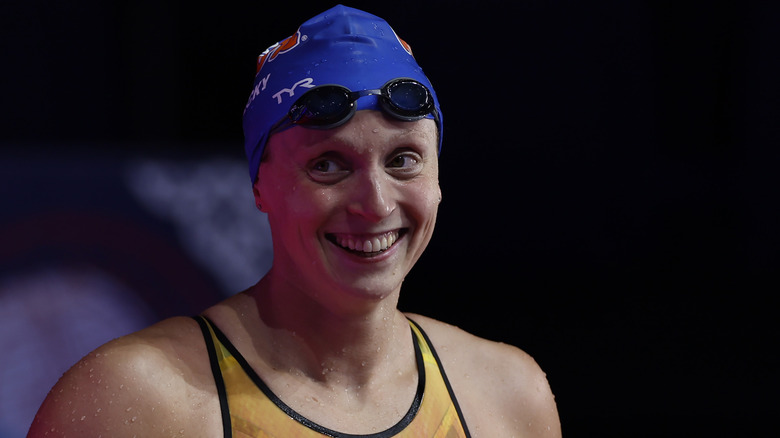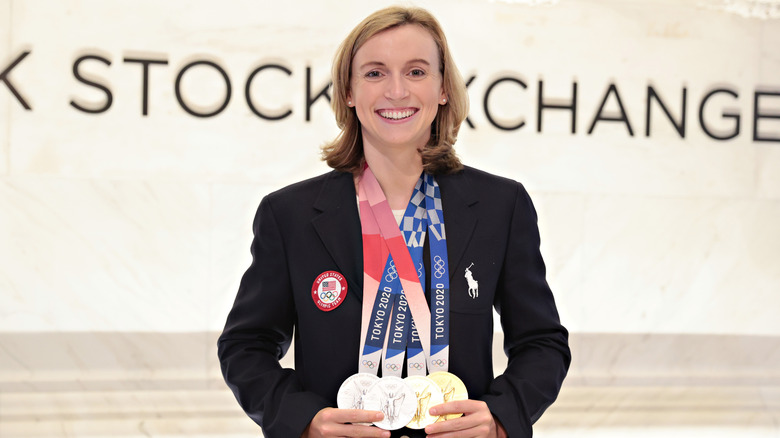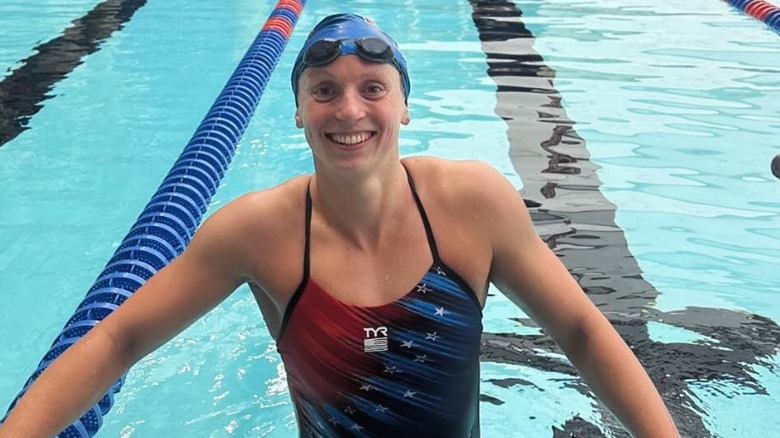Katie Ledecky Looks So Different With Makeup On
Katie Ledecky is one of the best swimmers of all time. She has seven Olympic gold medals and 21 World Championship titles as of June 16, 2024. As Ledecky spends most of her life training or competing in pools, people usually see her barefaced with a cap and goggles (dripping with water). However, when she does step out for a special event, a little bit of makeup makes the transformation of Ledecky pretty notable.
Still, she's not a fan of going full-out glam. No caked-on eye shadow and fake eyelashes; Ledecky prefers to keep the makeup minimalist, plumping for neutral colors, such as almost nude lipstick. What makes the biggest difference, though, is Ledecky's eyebrows. They are usually nearly invisible but add a new dimension to her appearance when penciled in. Ledecky is one of those lucky people who have been blessed with a perfect complexion — despite spending most of her time submerged in chlorine. So, it's little surprise she chooses not to slap foundation all over her face (though she did get a little more glam for the cover of her book, "Just Add Water.")
The sports star has little time to focus on hair and makeup. Instead, she's all about the diet and training. This, for many, would be a total chore, but luckily for Ledecky, she's totally here for the exercise regime. "I don't see going to the gym as work — I see it as playtime. It's fun for me," she told Women's Health in March 2021. "I'm pretty good at staying focused on my own goals and not paying attention to any expectations that might be on me."
Ledecky keeps her makeup minimalist
It's clear that Katie Ledecky looks quite different with dry hair and makeup, but she's been at home in the pool for years — making her Olympic debut in London in 2012 when she was 15. To say she made a splash would be an understatement. The teen smashed the 800 freestyle, taking home gold straight out of the gate. "I never thought I would make it there," Ledecky told The Guardian in June 2024. "I never dreamed of that as a young kid." She likely never dreamed of scoring more golds than any other female swimmer in Olympic history, either.
Regarding Ledecky's diet, a few things might raise eyebrows, as her celebratory chow down after scoring two golds and two silvers at the Tokyo 2020 Olympics wasn't exactly what you'd expect for an athlete. "I only had about an hour to get ready [for interviews], so I literally just had cereal on a PB&J," Ledecky told E! News in August 2021. "That night, though, for dinner, I was doing media somewhere else, and they had a lot better food. So I did get a hamburger there and that was great!"
Still, don't be fooled into thinking that's the swimmer's usual regime — far from it, as she usually consumes way more. Ledecky opened up about her pre-Rio de Janeiro Olympics 2016 diet in an interview with ESPN in August 2016, and let's just say although there wasn't a sniff of burgers, peanut butter was still a staple.
Ledecky eats and trains seemingly nonstop
Katie Ledecky gave ESPN a rundown of her training diet in August 2016. On her way to swim practice at 4:15 a.m., she has peanut butter on toast and fruit. After practice, around 7 a.m., it's a bagel with cream cheese and eggs; a bacon, egg, cheese, and tomato omelet and potatoes; or yogurt and berries; usually washed down with chocolate milk. Around midday, Ledecky has granola and yogurt with fruit before her gym workout.
Then, she loads up on carbs: chicken, avocado, and pasta. This is followed by a fruit snack or more PB on toast. Then, after her third workout of the day — this time back in the water, there's more yogurt and chocolate milk. And for dinner, it's a carb, protein, and veggie combo, such as pasta with beans, arugula, and chicken or steak. Phew!
People often wonder how much Olympic athletes really make. Well, it really depends on their abilities and profile, but it can definitely be a fair bit because we're talking serious numbers when it comes to how much Ledecky is worth. According to Forbes, the swimmer brought in an estimated $3 million in a year from sponsorship deals in 2021. Meanwhile, less famous and lower-achieving athletes scrape by with much less. "Most of our [athletes] make less than $50,000 a year, and for many, much less than that," Tom Jackovic, CEO of the USA Track & Field Foundation that allocates private cash grants to aspiring track and field Olympians, told Forbes.



